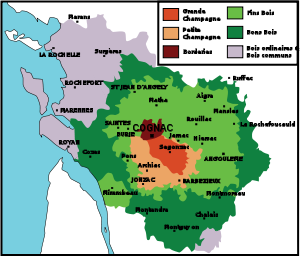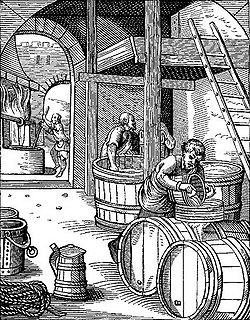Cognac (drink)
Cognac (pronounced /ˈkɒnjæk/ KON-yak), named after the town of Cognac in France, is the most famous variety of brandy. It is produced in the wine-growing region surrounding the town from which it takes its name, in the French Departements of Charente and Charente-Maritime.
According to French Law, to bear the name Cognac, the production methods for the distilled brandy must meet defined legal requirements, ensuring strict conformity with a 300-year old production process. It must be made from at least 90% Ugni Blanc, Folle Blanche or Colombard grapes; of these, Ugni Blanc, known locally as Saint-Emilion, is the most widely-used variety today. It must be distilled twice in copper pot stills and aged at least two years in French oak barrels from Limousin or Tronçais. Most cognacs are aged considerably longer than the minimum legal requirement of two years, because cognac matures in the same way as whiskies and wine when aged in a barrel.
Fine, aged cognac is appreciated and collected by connoisseurs in much the same way as fine French wines and old Irish and Scottish whiskies.
Contents |
Producing region and legal definitions

The region authorised to produce cognac is divided into six zones, including five crus (singular cru), broadly covering the department of Charente-Maritime, a large part of the department of Charente and a few areas in Deux-Sèvres and the Dordogne. The six zones are: Grande Champagne, Petite Champagne, Borderies, Fins Bois, Bon Bois and finally Bois Ordinaire. A blend of Grande and Petite Champagne Cognacs, with at least half coming from Grande Champagne, is known as Fine Champagne.
Note: these cognac-producing regions in southwestern France should not be confused with the northeastern region of Champagne, a wine region that produces sparkling wine by that name, although they do share a common etymology – both being derivations of a French term for chalky soil.
Production process
Cognac is made from eaux-de-vie (literally "waters of life") produced by doubly distilling the white wines produced in any of the growth areas. This drink was first created to use up the grape waste of wine making, and was considered a drink for the poor. The wine is a very dry, acidic, thin wine, not really suitable for drinking, but excellent for distillation. It may be made only from a strict list of grape varieties: primarily Ugni Blanc, Folle Blanche and Colombard, although 10% of the grapes used can be Folignan, Jurançon blanc, Meslier St-François (also called Blanc Ramé), Sélect, Montils or Sémillon.[1][2] Distillation takes place in traditionally shaped Charentais copper stills, also known as an alembic, the design and dimensions of which are also legally controlled. Two distillations must be carried out; the resulting eau-de-vie is a colourless spirit of about 70% alcohol.
Once distillation is complete, it must be aged for at least two years before it can be called 'Cognac' and sold to the public.
The final product is usually diluted to 40% alcohol content (80 proof) with pure and distilled water.
The age of the cognac is calculated as that of the youngest eau-de-vie used in the blend. The blend is usually of different ages and (in the case of the larger and more commercial producers) from different local areas. This blending, or marriage, of different eaux-de-vie is important to obtain a complexity of flavours absent from an eau-de-vie from a single distillery or vineyard. Each cognac house has a master taster (maître de chai), who is responsible for creating this delicate blend of spirits, so that the cognac produced by a company today will taste almost exactly the same as a cognac produced by that same company 50 years ago, or in 50 years' time. In this respect it is similar to the process of blending whisky or non-vintage Champagne to achieve a consistent brand flavor. A very small number of producers, such as Guillon Painturaud and Moyet, do not blend their final product from different ages of eaux-de-vie to produce a 'purer' flavour (a practice roughly equivalent to the production of single malt Scotch whisky). [3] Hundreds of vineyards in the Cognac AOC region sell their own cognac. These are likewise blended from the eaux-de-vie of different years, but they are single-vineyard cognacs, varying slightly from year to year and according to the taste of the producer, hence lacking some of the predictability of the better-known commercial products. Depending on their success in marketing, small producers may sell a larger or smaller proportion of their product to individual buyers, wine dealers, bars and restaurants, the remainder being acquired by larger cognac houses for blending. The success of artisanal cognacs has encouraged some larger industrial-scale producers to produce single-vineyard cognacs.
Grades
The official quality grades of cognac are, according to the BNIC (Bureau National Interprofessionnel du Cognac):
- VS Very Special, or ✯✯✯ (three stars) where the youngest brandy is stored at least two years in cask.
- VSOP Very Special (less commonly, but officially according to the BNIC, 'Superior') Old Pale, where the youngest brandy is stored at least four years in a cask, but the average wood age is much older.
- XO Extra Old, where the youngest brandy is stored at least six, but average upwards of 20 years. On April 1, 2016, the minimum storage age of the youngest brandy used in an XO blend will be set to ten years.[4]
In addition the following can be mentioned:
- Napoleon Although the BNIC states this grade is equal to XO in terms of minimum age, it is generally marketed in-between VSOP and XO in the product range offered by the producers.
- Extra A minimum of 6 years of age, this grade is usually older than a Napoleon or an XO.
- Vieux Is another grade between the official grades of VSOP and XO.
- Vieille Réserve Is, like the Hors d´Âge, a grade beyond XO.
- Hors d'âge The BNIC states that also this grade is equal to XO, but in practice the term is used by producers to market a high quality product beyond the official age scale. Hence the name "Hors d'âge" (beyond age).
No house of cognac produces all the above mentioned grades/qualities.
The crus where the grapes were grown can also be used to define the cognac, and give a guide to some of the flavour characteristics of the cognac:
- Grande Champagne (13766 hectares total) Grande Champagne eaux de vie are long in the mouth and powerful, dominated by floral notes. The most prestigious of the crus. "Champagne" derives from the Roman "Campania" meaning Plain, but is often explained with similarity in soil with the Champagne area at Rheims. Cognacs made from a mixture of Grande and Petite Champagne eaux de vie (with at least 50% Grande Champagne) may be marketed as Fine Champagne.
- Petite Champagne (16171 hectares total) Petite Champagne eaux de vie have similar characteristics to those from Grande Champagne but are in general shorter on the palate.
- Borderies (4160 hectares total) The smallest cru, eaux de vie from the Borderies are the most distinctive, with nutty aromas and flavour, as well as a distinct violet or iris characteristic. Cognacs made with a high percentage of these eaux de vie, for example, "Cordon Bleu" by Martell, are dominated by these very sought-after flavours.
- Fins Bois (34265 hectares total) Heavier and faster ageing eaux de vie ideal for establishing the base of some blended cognacs. Fins Bois is rounded and fruity, with an agreeable oiliness.
- Bons Bois
- Bois Ordinaires (19979 hectares together with Bons Bois). Further out from the four central growth areas are the Bons Bois and the Bois Ordinaires grown regions. With a poorer soil and very much influenced by the maritime climate, this area of 20,000 hectares produces eaux de vie that are less demonstrative and age more quickly. These less prestigious crus are excluded from blends by some smaller boutique manufacturers and are generally used for high-volume production.
The growth areas are tightly defined; there exist pockets with soils atypical of the area producing eaux de vie that may have characteristics particular to their location. Hennessy usually uses the unofficial brandy grades for its cognac offerings, but has also produced three single distillery cognacs, each with very distinctive flavours arising from the different soils and, to a lesser extent, climate. Other cognac houses, such as Moyet, exclusively use the crus to describe their different cognacs.
Companies and brands
Cognac is sold mainly by trading houses. Some of them were founded centuries ago, and still dominate the market today. In addition to the major Cognac houses, many smaller artisanal producers still survive.
Brands of cognac include:
|
|
The top cognac houses also produce premium-level brands, including:
- Rémy Martin's Louis XIII is blended from more than 1,200 eaux-de-vie aged a minimum 55 years (usually 65-100+) in very old Limousin oak barrels, and individually numbered and owner-registered.
- Richard Hennessy is a blend of over 100 eaux-de-vie aged up to 200 years and is named after the founder of the company.
- L'Esprit de Courvoisier is blended from eaux-de-vie up to 200 years old, and individually numbered.
- Moyet's Très Vieille Fine Champagne and Très Vieille Grande Champagne cognacs are blended from some eaux-de-vie barrels that are over 150 years old, individually numbered and with labels signed by the cellar master.
Cognac and hip-hop culture
Since the early 1990s, cognac has seen a significant transformation in its American consumer base, from a predominantly older, affluent white demographic to a younger, urban, and black consumer. Cognac has become ingrained in hip hop culture, celebrated in songs by artists ranging from Tupac Shakur [5] to Busta Rhymes [6] to Biggie Smalls to Ludacris and Nas.[6]
It is estimated that African Americans now comprise 60-80% of the American cognac market. A majority of African Americans have indicated in studies that the endorsement of popular musical artists is a key factor in their preference for cognac. Moreover, Pernod-Ricard, the parent company of Martell, has acknowledged that “the USA is the biggest market for cognac, and African-Americans are a priority target.”[7] After poor sales in 1998 due to an economic crisis in Asia — cognac’s main export market at the time — sales of cognac increased to approximately US $1 billion in America in 2003. This was a growth that coincided with hip-hop’s entry into the mainstream of American music.
Cognac-based drinks
- Grand Marnier: Made from cognac and distilled essence of bitter orange.
- Pineau des Charentes: A sweet aperitif, composed of eau-de-vie and grape must, made in the Charente region.
See also
- Cocktails with brandy or cognac
- Brandy
- Vinjak
References
- ↑ "Appellation of Origin". Bureau National Interprofessionel du Cognac. http://www.cognac.fr/cognac/_en/2_cognac/index.aspx?page=appellation.
- ↑ "Harvesting and vinification". Bureau National Interprofessionel du Cognac. http://www.cognac.fr/cognac/_en/2_cognac/index.aspx?page=vendanges.
- ↑ "Single Estate Cognac". 2009. http://www.singleestatecognac.com. Retrieved 2009-07-21.
- ↑ http://blog.cognac-expert.com/vs-vsop-xo-what-does-mean-napoleon-grade-blending/
- ↑ "Obama gets his own cognac: The Swamp". Swamppolitics.com. 2009-01-15. http://www.swamppolitics.com/news/politics/blog/2009/01/obama_gets_his_own_cognac.html. Retrieved 2009-05-03.
- ↑ 6.0 6.1 Lichfield, John (2003-07-27). "Cognac stages a comeback as rappers' drink of choice - Europe, World". London: The Independent. http://www.independent.co.uk/news/world/europe/cognac-stages-a-comeback-as-rappers-drink-of-choice-588152.html. Retrieved 2009-05-03.
- ↑ http://www.pernod-ricard.com/medias/Finance/PDF/PR%20Entreprendre%2043%20GB.pdf
Referenced in the Bollywood film Dilwale Dulhania Le Jaayenge starring Shahrukh Khan and directed by Aditya Chopra.
External links
- (English) The BNIC Cognac encyclopedia
- (English) Cognac official website Bureau National Interprofessionel du Cognac
- SFGate Article: Newspaper article
|
|||||||||||||||||||||||||||||||||||||||||||||||||||||||||||||


